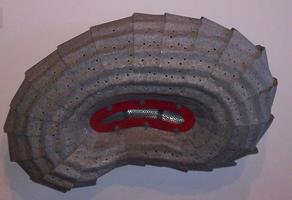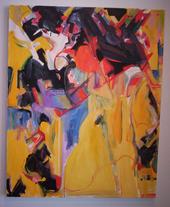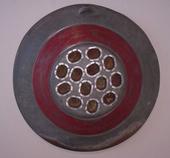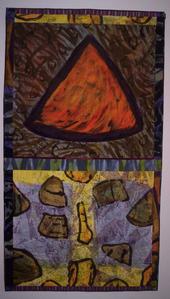 Tactile, warm, and vibrant quilts wage a playful dogfight with large and bold oil paintings dripping with lush colors, offset by lightly weathered pods of overlapping metal plates. Just a few miles away, their siblings passively engage each other in a nonchalant visual standoff.
Tactile, warm, and vibrant quilts wage a playful dogfight with large and bold oil paintings dripping with lush colors, offset by lightly weathered pods of overlapping metal plates. Just a few miles away, their siblings passively engage each other in a nonchalant visual standoff.
Can this really be the same exhibit?
Even though the Quad City International Airport has one of the best galleries in the area, it is challenging to motivate people to go and see artwork there when they aren't using the airport. The work shown in the airport is viewed - and by the nature of where the waiting area is - contemplated by far more people than any of the traditional art venues in the Quad Cities. But only the most avid art-lovers travel to the airport specifically to see a show.
 Conversely, how do you get those record-setting crowds moving through the Moline airport to travel to Rock Island to see local artwork at Quad City Arts (specifically) and The District (in general)?
Conversely, how do you get those record-setting crowds moving through the Moline airport to travel to Rock Island to see local artwork at Quad City Arts (specifically) and The District (in general)?
In an effort to increase awareness and help generate cross-traffic between two of its exhibition venues, Quad City Arts is presenting a joint exhibit that utilizes both the Quad City Arts gallery in Rock Island and the airport gallery. The underlying objective is to entice the patrons of one gallery to make the pilgrimage to the other location by splitting a show between both venues.
This "double" show features three area artists: Brian Roberts, a no-nonsense sculptor from Pella, Iowa; Joel Smith, a predominately oil-on-canvas painter from Colchester, Illinois; and Astrid Hilger-Bennett, a fabric dyer/assembler/quilter/painter from Iowa City. While both venues host works by the same three artists, the unique physical nature of the spaces changes how the artworks resonate with each other.
The sculptural forms of Brian Roberts are simple and eloquent. In Mouth, Roberts fashions rounded, overlapping plates of corrugated and highly perforated galvanized metal into a three-dimensional pear-shaped vessel. Several of his works - such as Mum, Untitled, and Untitled (Drain II) - use a similar method of fabrication to create intriguing organic forms such as circles or ovoids.
Roberts' artist statement makes reference to the importance of his "agricultural background" and his "family's farming roots" in developing his subject matter and his straightforward manner of fabrication. His rural empathy allows him to succinctly imbue man-made materials with an organic sensibility.
Roberts' penchant for transformation of quotidian farming materials into organic metaphors is facilitated with titles such as Mouth or Bean or Mum. These simple words help to suggest that what is being viewed is symbolically more than a collection of metal.
 A rounded, shield-like form of concentric circles, Cell is another excellent demonstration of the dual identity Roberts cultivates within his works. Here, he takes cupcake-sized, sieve-like pieces and groups within "visual walls" so that it reads as both a compositionally pleasing grouping of forms and something from "cheek cell under the microscope day" in freshman biology.
A rounded, shield-like form of concentric circles, Cell is another excellent demonstration of the dual identity Roberts cultivates within his works. Here, he takes cupcake-sized, sieve-like pieces and groups within "visual walls" so that it reads as both a compositionally pleasing grouping of forms and something from "cheek cell under the microscope day" in freshman biology.
Joel Smith plays with balance, density, color, and painterly fragments of typography within his paintings. He builds his images with each color passage and brush stroke informing the next one. The end result is not knowable at the start of the process, because each piece is a visual documentation of an artistic journey versus a straightforward execution of an idea.
Typically, the top half of his works is densely laden with slashes of movement and small interactive forms of color buoyed on a calmer sea of larger and less energetic masses toward the bottom. By placing the majority of the frantic activity in the top half, Smith infuses his paintings with a light and vital energy.
Deviation is a prime example of Smith's playful use of color and movement. Thin orange lines help to confine and define the masses of honey yellow, which hold aloft a tumultuous bundle of cadmium reds, cotton-candy purples, and slightly toned blacks. Some of the truly black (neither "warmed" or "cooled" by another hue) forms steal some of the interactive energy that otherwise tries to ricochet throughout the piece.
Smith's surrounding use of black to accentuate the billowing white "Y" within Vortex is outright captivating. Here the artist has temporarily frozen a bulbous form of white plumes accentuated with orange lines, pale pumpkin yellows, and hints of blue and red. The result is a bulging mass of a marshmallow-like muscular Satyr feverishly dancing onto the canvas with a casual nod to Marcel Duchamp's Nude Descending a Staircase, No. 2.
In some passages, Astrid Hilger-Bennett's art quilts have a limited range of values and colors that seems to negate the more dynamic and vivacious areas. In other areas, though, the jubilant movement of playful forms is almost explosively lit on fire by the haunting luminosity of her colors.
The dull brown over a blue background on the top half of her Floating World is an example of how one area functions more to counteract (as in to negate) the activity of another area rather than to provide a counterbalance (which allows both areas to realize their own inherit character while symbiotically interacting with the other). It prevents the orange, pie-shaped wedge from fulfilling its full interactive potential with the smaller brown and yellow forms that actively populate the bottom register.
 But in Botanical Variation, the three orange lily-esque forms with dark outlines are set off by a maroon swath over a light green background toward the top and purple over blue on the bottom. The colors not only work together; they energize each other. The rhythmic patterning of shapes, colors, and materials that Hilger-Bennett established in the border area helps contain - in a playful and loosely structured way - this luminous banquet for the eyes in the center.
But in Botanical Variation, the three orange lily-esque forms with dark outlines are set off by a maroon swath over a light green background toward the top and purple over blue on the bottom. The colors not only work together; they energize each other. The rhythmic patterning of shapes, colors, and materials that Hilger-Bennett established in the border area helps contain - in a playful and loosely structured way - this luminous banquet for the eyes in the center.
Microcosm is another visual home run, with reddish-maroon forms accented with yellows and oranges that sprawl over the three main registers of apple greens. The two vertical bands of red and yellow help impose order on the composition, much like the mullion in a window helps to organize the space on the other side by providing it with an overlying visual structure.
The hanging of any show is a compositional work in itself and can be as important as the creative effort poured into each piece; it is the final composition to be created. Pacing, proximity, and interactive and informative potential are all things that should be considered.
The smaller airport space requires works to intermingle in closer proximity to each other. In some places, the works are hung higher or lower than eye level and are used to establish rhythmic variations from large to small and from flat to dimensional.
The pieces in the show at Quad City Arts gallery need to occupy and activate a much larger space. The nature of the space strongly suggests, if not downright demands, a Sousa-like rhythm of pieces marching along the wall. As a result, the dynamic call-and-response potential - fully realized at the airport - is unfulfilled at Quad City Arts, ending up more lethargic and sporadic.
Because of the nature of how Quad City Arts rotates it exhibitions, you will only be able to see both shows until the end of this week. However, the more energized and compelling airport show will stay up until the end of April.










